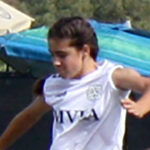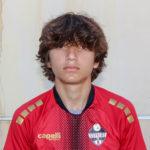Shin splint season: Danger looms when athletes change playing surfaces
 The cold and shortened days are driving us indoors – if we can find space (!) – for training and play. Lots of kids who have been soccering all fall will take a break (as advised in last week’s post) and play winter basketball or run winter (“indoor”) track. I think this is great. A little diversity and a new group of kids adds interest and challenge and fun. All good.
The cold and shortened days are driving us indoors – if we can find space (!) – for training and play. Lots of kids who have been soccering all fall will take a break (as advised in last week’s post) and play winter basketball or run winter (“indoor”) track. I think this is great. A little diversity and a new group of kids adds interest and challenge and fun. All good.
Just watch out when they change surfaces. Numerous kids and parents have alerted me to the onset of shin pain in their soccer-fit athletes when they hit the indoor gyms. Here’s why: Fit athletes move fast, jump high and play lots of minutes, but their bodies haven’t had time to adapt to the playing surface. Their hard-working feet and legs are particularly startled and at risk.
The muscles that run along the length of the front of their shins experience micro-trauma, small tears in the attachment of the muscles to the bones, and they become inflamed. This is painful. This is what’s known as shin splints.
What are the symptoms of shin splints?
- Tenderness along the crest of the shin bone (front/anterior) or distal third of the tibia*
- Pain with applied pressure
- Pain may go away after warm up
- Shin area may be red as well as sore
- A longer, more diffuse area of pain, or bump or ridge at the site of pain, may indicate a more serious condition called a stress fracture
What causes (or increases the risk for) shin splints?
- Running on hard surfaces in non-cushioned, unsupportive shoes
- Improper running form, (e.g., running on the toes or with heavy, flat-footed steps that pound or slap the ground)
- Poor calf flexibility and tight tibial muscles which decrease cushioning in landings
- Change in running surface and/or sudden increase in training volume
Kids are especially at risk because they are growing, and all the body’s attachments are a bit fragile. If they are playing for multiple coaches, no single coach is monitoring the volume of training. Parents must be aware; they have the eagle eye here. At the first signs of this injury or impending injury in our kids, we need to choose rest and reduced training.
But kids may write off a little discomfort. They’re kids; they want to keep going. This can be dangerous. Shin splints can become stress fractures. An athlete with a stress fracture must rest the leg completely for at least six weeks until the bone scan (a specialized radiological test for bone healing and recovery) is clear and the athlete is pain-free. If an athlete continues to play on a stress fracture, he risks a complete or more involved fracture. Let’s not let it come to this. Prevention is imperative! Rest is essential.
How Can We Help Prevent Shin Splints?
** (see F2F for simple strengthen and stretch program to beat shin splints)
- Strengthen the anterior tibial muscles (toe raises off step)
- Stretch Achilles tendon/calf muscles (lower heel from standing over the edge of step)
- Supportive, well-fitting footwear
- Arch supports (to decrease pronation) may help
- At first sign of shin splints, reduce training and avoid running on hard surfaces
- Discourage the wearing of high-heeled shoes
Even when we switch or alternate sports, we have to watch out for over-training errors that cause injury. They generally happen when we use the same muscles through the same motion over and over, and especially if we increase volume or intensity rapidly. This may sound very much like practice. We need to mix this up. Mix up the demands, the movements, the intensity and, if possible, the surfaces. The body craves cross-training, and we can be creative about supplying this.
Years ago I heard an orthopedist speak about the many young soccer athletes she treated for overtraining injuries of the foot and ankle, with repercussions to the leg, knee and hip. She pointed first to their feet. “Just look at what’s inside their shoes. It’s like running on a piece of cardboard,” she said.
[ +Picking out boots: How in the world do I choose? ]
We soccer athletes are minimalists. We don’t want anything to get in the way of our “feel” for the game. Not laces, not weight, not heavy shin pads or ankle protection. We want to go au naturale. Let me suggest that we put a little cushion under our feet and a little support around our pronating or supinating ankles, especially in our kids, particularly when they train.
Runners wear shoes designed for the rigors of running with cushioned heels and flexible toes. Basketball players wear shoes designed to support side to side movement and jumping and landing. Soccer players, because we go every-which-way, are generalists of a sort. We need a bit of everything instead of a lot of nothing.
Let’s treat our feet well. They’re our weapon of choice, after all. The rest of our body will thank us.
SOCCERWIRE MARKETPLACE
- Wanted Licensed Youth Soccer Coach
- Join Official Elite Summer Soccer Camps with Europe’s Top Pro Clubs!
- The St. James FC Travel Staff Coach - North (Loudoun) & South (Fairfax)
- The St. James FC Girls Academy (GA) Head Coach - 2 teams
- The St James FC Boys Travel Tryouts
- OFFICIAL BAYERN MUNICH SUMMER CAMPS U.S.
- JOIN THE ALLIANCE!
- OFFICIAL FC BARCELONA CAMPS U.S.
- The Cup San Diego - Hosted by Legends FC
- Players Wanted - Undergraduate or Post-graduate













